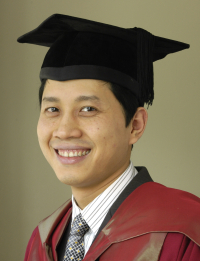 Bui Thanh Tu has recently passed his PhD viva at Wessex Institute of Technology with a thesis entitled ‘An overlapping sub-domain technique and meshless radial basis integral equation method’. His external examiner was Prof. Henry Power from the University of Nottingham and the internal was Prof. Carlos Brebbia.
Bui Thanh Tu has recently passed his PhD viva at Wessex Institute of Technology with a thesis entitled ‘An overlapping sub-domain technique and meshless radial basis integral equation method’. His external examiner was Prof. Henry Power from the University of Nottingham and the internal was Prof. Carlos Brebbia. Bui Thanh Tu received his Master of Engineering from National University of Singapore attached to the Institute of High Performance Computing in Singapore. In 2006 he came to WIT and started his PhD programme under the supervision of Prof. Viktor Popov.
In his research, the domain decomposition boundary element method with overlapping sub-domain technique was introduced. This technique was based on the domain decomposition Boundary Element Method (BEM) with overlapping sub-domain and was combined with the Dual Reciprocity Method (DRM) with two different Radial Basis Functions (RBFs). The advantage of the approach was that it simplified the assembly of the equations arising from the BEM sub-domain methods while at the same time reduced the problem arising due to near-singular or singular integrals which may appear in the BEM formulation.
Subsequently, a meshless approach which uses circular overlapping sub-domains distributed inside the original domain of the problem was introduced. Since the source point is always in the centre of the circular sub-domain, singular integrals are avoided regardless of the order of the derivative of the original integral equation. In this approach the Radial Basis Function interpolation was applied to obtain the values of the field variables and partial derivatives at the boundary of the circular sub-domains. Dual reciprocity method (DRM) was applied to convert the domain integrals into boundary integrals. The meshless approach was applied to solve diffusion-convection problems and the Navier-Stokes equations. The results obtained using the current approach were compared to previously reported results obtained using the Finite Element Method (FEM), and the DRM multi-domain approach (DRM-MD) showing similar level of accuracy.
Both examiners congratulated Tu on the work presented and recommended that he be awarded the degree of Doctor of Philosophy.

 Wessex Institute
Wessex Institute